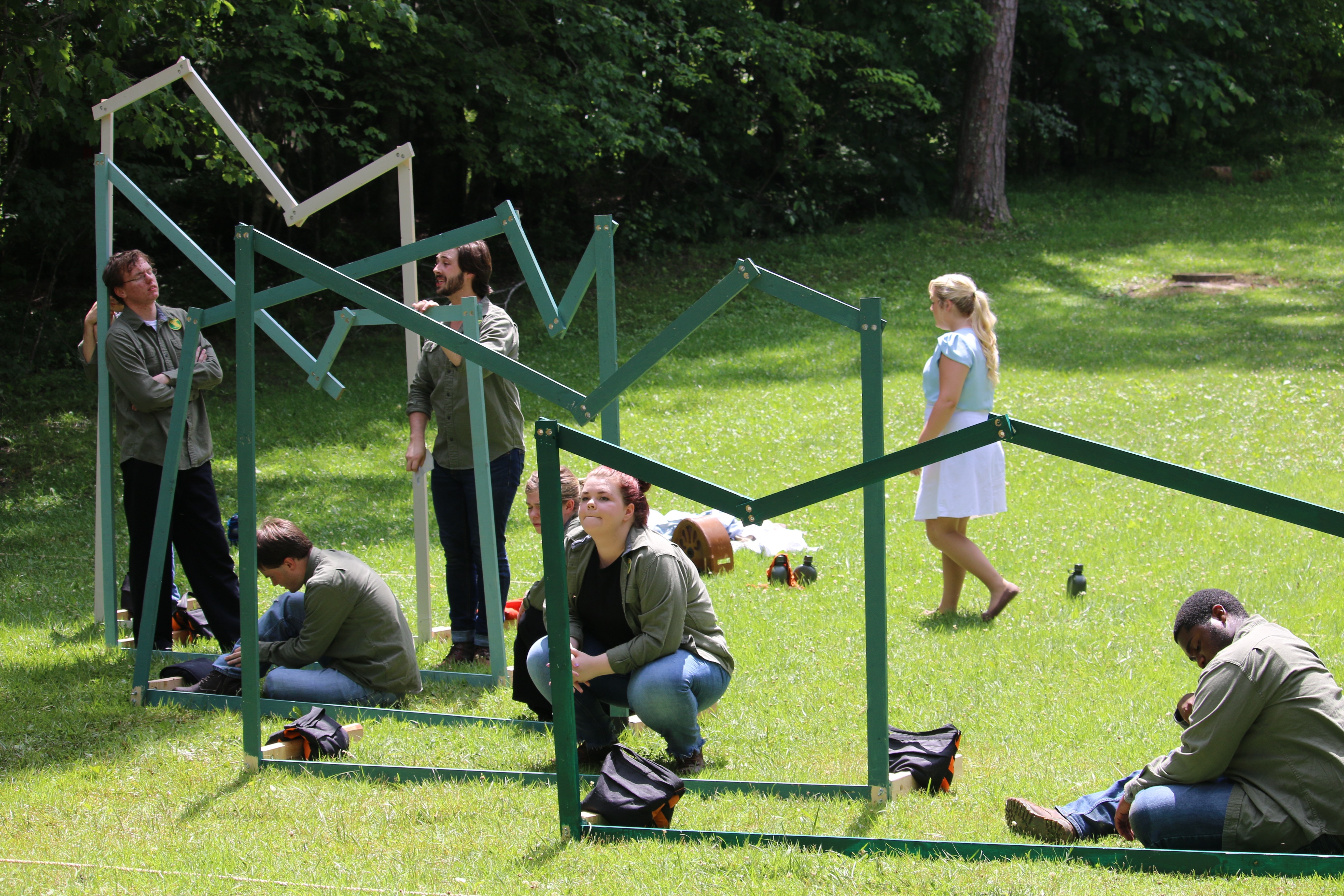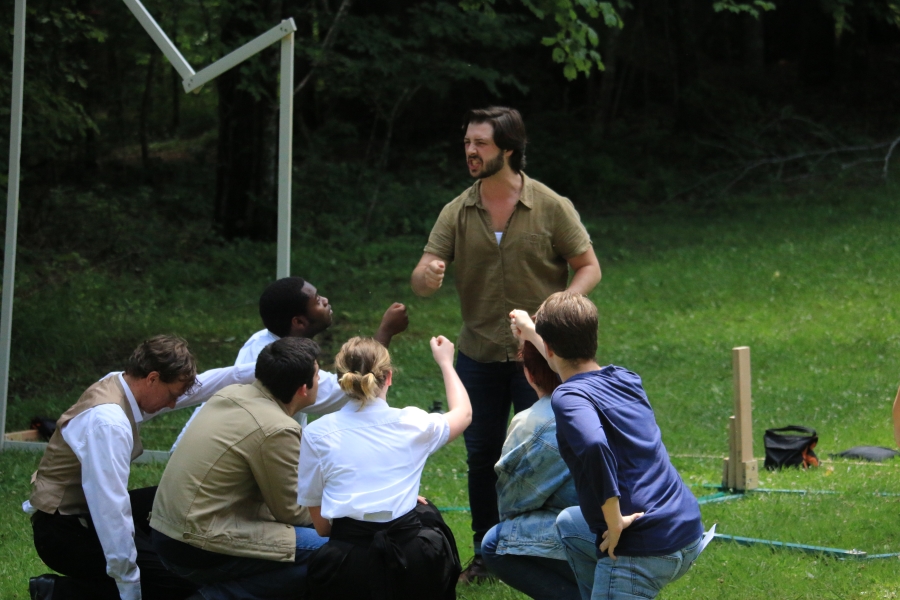Wherever director Annie G. Levy goes, she finds a favorite tree. It’s a game she’s played since she was young—“such an only child thing,” Levy modestly chuckles. So when Levy—a thrice-degreed, Ivy-groomed Manhattanite—left her faculty position at Pace University to lead the MFA Directing program at the University of Alabama, she was sure to find a favorite tree in Tuscaloosa, Ala. Luckily, there were many trees to choose from.
To some, Levy’s journey could seem reminiscent of the premise behind the 1990s television show “Northern Exposure,” a fish-out-of-water setup where a Jewish Columbia grad disembarks from the comfort of America’s biggest city for something more rural. What Levy found was a community of artists, students, and collaborators who care about theatre just as much as they care about “Roll Tide” football. She also found an opportunity to revive and tour a show in a state where the themes are wildly relevant.
Amid the crockpot temperatures of the Southern summer, Levy and an ensemble of University of Alabama theatre students toured a devised play about the Civilian Conservation Corps—in the very state parks that the corps built.
Never heard of the CCC? Neither had Levy. Hence the mission of her piece, Tree Army.

It was during the Great Recession, while instructing at Pace, that Levy became captivated with a nine-year-long chapter often skipped over in American history, in which the government employed millions of young men to plant trees, string phone lines, and fight forest fires. “I’d heard of the New Deal, I heard of the Works Progress Administration, but I had never heard of the CCC,” she said.
When the Great Depression starved the country, Franklin Delano Roosevelt was elected to play out his “new deal for the American people,” as Herbert Hoover’s bootstraps-ism hadn’t been working too well for millions of families hungry for work and food. Within weeks of FDR’s election, legislation was passed to create a regimented force of single men ages 17-25 to perform labor across America. Despite resistance—some worried that FDR intended to build up a Hitler-like youth army—the Civilian Conservation Corps was quickly christened.
For one dollar and three “square meals” a day, young men from around the nation could go to work and send money back to their struggling families. In addition to the money in their pockets and the food on their plates, the boys of the CCC got an education in reading and writing, practical trades, and a warm bed (which they made, military-style, every morning).
“Young people from all across the country were basically being put into this experiment in communal living,” says Levy. “Some of these men who enrolled in the CCC never left their hometown…they were all put together and forced to deal with each other.”
To get the CCC operating quickly, the Departments of Labor, War, Interior, and Agriculture all swiftly collaborated to make FDR’s vision of a “tree army” a reality.
Such governmental teamwork feels outdated in these cynical modern times of partisan political gridlock. During the recession, as Levy watched a Congress band together in the name of party absolutism to deny any and all of President Obama’s initiatives, the New Deal’s efficiency felt like the stuff of lore.
“Roosevelt sent legislation to create the CCC within weeks of becoming president,” says Levy. “When I thought about that in terms of where we were—and are—politically, the CCC seemed to pass into this realm of American mythology.”
For Levy, whose body of work fixates on the mythic, the forgotten history of millions of young men working and learning together was an American mythology too remarkable to leave untouched.
The project started with a group of undergraduate theatre students at Pace. Levy “downloaded” her newfound enthusiasm about the CCC with the Pace actors and together they began researching, combing through firsthand accounts and archival documents. From there they went through the collaborative process of dramatizing the artifacts of the CCC into a devised piece of stagework.
For Levy, it made dramaturgical sense to work on the piece with actors who were the same age as the CCC recruits. “You know, cognitively, we know that what we thought of as the teenage brain growth actually goes to 25,” Levy exclaims sparklingly. “So there’s this huge cognitive change! This [age] is the time to be imprinting a love of community, a love of nature, a love of—I don’t want to get too Communist here, but working toward the greater good.”
Together, the ensemble of students and their professor worked to make a 70-minute-or-so stage collage of the CCC that was part documentary, part storytelling, part musical (there is a delightful hymn to the camp’s hot meal menu items).
There were bugaboos for Levy to face in representing the story of the CCC comprehensively. The CCC was segregated, and stunted the admissions of African Americans, migrant workers, and Native Americans, using a rationale based on inaccurate census statistics. And of course it was only for boys. Eleanor Roosevelt launched the less-popular She-She-She camps as a sibling program.
Then there’s the very nature of the program itself—the CCC represented government intervention at a level that looks socialistic by today’s standards. Levy didn’t know what to expect bringing the show down to the notoriously conservative Alabama, where apart from Doug Jones Republicans have ruled the roost since the Civil Rights Act of 1964, and “socialism” often serves as a threatening buzzword.
Tree Army had initially performed at Governors Island in NYC (where the CCC was once headquartered for the region) and at the Irondale Center in Brooklyn. But how would it fly in a state where government intervention can be a stubborn point of resentment for many of the conservative-leaning?
“Alabama, from what I’ve experienced, has a powerful connection to its CCC legacy, the state parks especially,” says Levy. This is not only because the CCC boys built many Alabama parks, but also because many of those boys were Alabamians.

“I don’t think I became personally invested in [the show] until I spoke with my grandparents about it,” says actor Libby Williams, a Theatre and Visual Arts major from Georgia. “They asked me what I was doing this summer, and I told them, ‘We’re doing a show about the CCC,’ and they were like, ‘Oh my gosh, your great-grandfather was in that! That’s how he met his wife!’ So I partially owe my existence to the CCC,” she says, giggling.
These sorts of ancestral connections come up a lot, notes Levy. A few days after the ensemble started rehearsals in Alabama, the production’s music director found out he had a relative who was a CCC alum.
During the New Deal days, Alabama had an average of 30 CCC camps operating during any given year, employing roughly 67,000 Alabama boys, many of whom learned to read and write in the program.
Personal relationships brought many Alabamian audiences to see Tree Army in the state parks, and federal and state grant funding with university support allowed the performances to be free of charge. Levy hopes that with similar support, the show can tour through state parks in Tennessee and Virginia next.
“In DeSoto State Park, the first place we went, when you enter the park there’s a very clear emblem that says ‘Built by the CCC,’” says actor Alaric Rohl, a Coloradoan on an advanced two-degree track at the university. “I hesitate to use this, but it was mind-blowing…We’re treading the path that the CCC boys once trod.”
Attending outdoor theatre in the Alabama summertime can be a rustic experience; audiences not only clap their hands to applaud but also to slap the occasional mosquito. I saw an open brush-up rehearsal of the performance on the university’s campus, in a little park built on a spring, right behind the ragtag theatre building, yards away from the school’s stately quad, in the shadow of the beloved football stadium.
The piece was an energetic meditation on the CCC, digging into its impact and investigating its demise, due to a drain by the draft for the Second World War. On the grassy stage and under the shade of the trees, young, sweating colleagues performed theatre for the Deep South. (I am one of three fully funded graduate directors at the university currently studying under Levy.)
In a country that has certain expectations about where theatre thrives, it can feel bold—if not isolating—to create work here. “There’s such a stigma with Southern artists and being not as great because we’re in Alabama,” says Williams. “I think it’s a silly stigma that Alabama, and the university especially, breaks constantly with the level of the work that goes on and the dedication that we bring.”
Indeed, when I attend national events or reconnect with friends from my undergraduate training in Boston, folks all but do a spit take when they find out I study theatre in Alabama. But productions like Tree Army are why we are here: We’re on a mission to create a more nimble and less fearful—dare I say more rooted?—American theatre.
Alex Ates is a writer, director, teacher, and actor from New Orleans. He is a contributing writer for Backstage.


